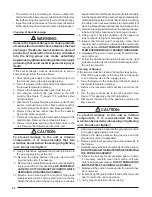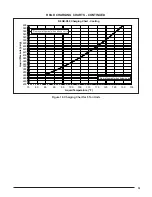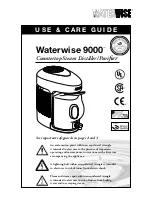
19
The integrated control starts the circulating air blower 30
seconds after the gas valve is opened. The control is factory
wired to turn the blower motor off 135 seconds after the
gas valve is closed. NOTE: The heating blower off delay
is factory set at 90 seconds. An additional 45 second off
delay is programmed into the X-13 blower motor for a
total of 135 seconds.
Verifying and Adjusting Firing Rate
CAUTION:
Do not re-drill the burner orifi ces. If the orifi ce
size must be changed, use only new orifi ces.
The fi ring rate must be verifi ed for each installation to
prevent over-fi ring of the furnace. The fi ring rate must
not exceed the rate shown on the unit data label. To
determine the fi ring rate, follow the steps below:
1. Obtain the gas heating value (HHV) from the gas supplier.
2. Shut off all other gas fi red appliances.
3. Start the unit in heating mode and allow it to run for at
least 3 minutes.
4. Measure the time (in seconds) required for the gas
meter to complete one revolution.
5. Convert the time per revolution to cubic feet of gas per
hour using Table 13 (page 27).
6. Multiply the gas fl ow rate in cubic feet per hour by the
heating value of the gas in Btu per cubic foot to obtain
the fi ring rate in Btu per hour. See Example.
Example:
• Time for 1 revolution of a gas meter with a 1 cubic
foot dial = 40 seconds.
• From Table 13, read 90 cubic feet gas per hour.
• Local heating value of the gas (obtained from gas
supplier) = 1,040 Btu per cubic foot.
• Input rate = 1,040 x 90 = 93,600 Btuh.
7. Adjust the manifold pressure if necessary. See Manifold
Pressure Adjustment instructions on page 20. For
additional information about elevations above 2,000
feet, see page 17.
Verify Over-Temperature Limit Control Operation
1. Verify the louvered control access panel is in place and
that there is power to the unit.
2. Block the return airfl ow to the unit by installing a close-
off plate in place of or upstream of the fi lter.
3. Set the thermostat above room temperature and verify
the units operating sequence (page 20).
NOTE: The over-temperature limit control should turn off
the gas valve within approximately four minutes (exact time
depends on the effi ciency of the close-off when blocking
the return air). The circulating air and combustion blowers
should continue to run when the over-temperature limit
control switch opens.
3. Remove the close-off plate immediately after the over-
temperature limit control opens. If the unit operates
for more than four minutes with no return air, set the
thermostat below room temperature, shut off power to
the unit, and replace the over-temperature limit control.
Verifying Burner Operation
WARNING:
Uninsulated live components are exposed when
louvered control access panel is removed.
1. Remove the louvered control access panel and verify
there is power to the unit.
2. Set thermostat above room temperature and observe
the ignition sequence. NOTE: The burner fl ame should
carry over immediately between all burners without
lifting off, curling, or fl oating. The fl ames should be blue,
without yellow tips. Make sure the fl ame is drawn into
the center of the heat exchanger tube. In a properly
adjusted burner assembly, the fl ame bends down and
to the right at the end of the heat exchanger tube. The
end of the fl ame will be out of sight around the bend.
3. After validating fl ame characteristics, set the thermostat
below room temperature and verify the burner fl ame
extinguishes completely.
Refrigerant Charging
WARNING:
R6GD units are shipped fully charged with
R-410A refrigerant and ready for installation.
When a system is installed according to these
instructions, no refrigerant charging is required.
If repairs make it necessary for evacuation and
charging, it should only be done by qualifi ed,
trained personnel thoroughly familiar with this
equipment. Some local codes require licensed
installation/service personnel to service this type
of equipment. Under no circumstances should
the owner attempt to install and/or service this
equipment. Failure to comply with this warning
could result in property damage, personal injury,
or death.
CAUTION:
This unit uses refrigerant R-410A. DO NOT use
any other refrigerant in this unit. Use of another
refrigerant will damage the unit.
The system refrigerant charge can be checked and
adjusted through the service ports provided at the front
panel. Use only gauge lines which have a “Schrader”
depression device present to actuate the valve. Draw a
vacuum on gauge lines to remove air before attaching
















































